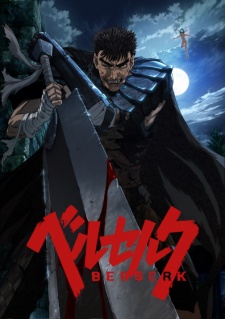
It's never good to reboot a franchise after nearly 20 years with as bad of a first impression as the 2016 Berserk. To say the original 1997 looked better is an understatement. When people point to older animation's ability to render disrepair, filth, darkness, horror, and just plain chaos, Berserk is a fantastic example because it is a show that could never survive without these aspects. The world of Berserk is utterly terrible through and through, the kind of medieval fantasy that makes Game of Thrones's Westeros look like a vacation spot by comparison. Death pervades along with the curse of the every ghoul and spirit imaginable, while religion offers escapism only through torture and execution. To render all that in poorly done 3D CGI, with a bright palate devoid of shadows or flecks of dirt, and to have the characters speak with a pace and rhythm that makes their every line sound like a joke or one-liner, is suicide for the show at best.
The core of the show still remains, and what the visuals fair to convey the story can't help but cover. Back in the present after the original Berserk's extended flashback of how the world fell into ruin, Guts the Black Swordsman is traveling town to town looking for his loved one, and for the mysterious Apostles that branded him with the cursed mark that ceaselessly calls evil spirits to kill him. The early episodes establish him in between the law and the chaotic forces of nature, by which I mean he is equally willing to hit both parties with the oversized hunk of metal he passes for a sword. A few chance meetings lead him to add the fairy Puck to his entourage of one, and a visit to a tranquil house in the countryside makes him seem like he could be a genuinely nice guy on the inside, before he gets back to screwing over the soldiers of the church again and we're reminded that most of his character operates along a single axis.
Finally we arrive in a small refugee enclave called Albion, and the story begins in earnest. The struggle between the walled fortress on the hill next to the camp and the struggling refugees starving below is exacerbated by the arrival of Father Mozgus, a brutal clergyman known for torturing and executing anyone who so much as sneezes the name of an idol god. In the town live a group of prostitutes, one of which seems to be unable to speak or properly think, but soon we are led to understand that it is Guts' lover, driven insane by the same heretical mark that he bears. Soon the clergy, the Holy Chain Knights who protect them, the townspeople, the cult hidden in their ranks, the prostitutes, Guts and his ragtag group, and all the evil spirits in a few mile radius come together in the same place, and...well from the story we can say tragedy ensues, but watching it all unfold I'm more tempted to call it “wacky hijincks”.
Overall, while the scenario and sheer depressing terror of the Berserk universe pull through and assert themselves more and more as the show progresses, I'm still left with the aftertaste of pure disappointment. There are dozens of shots that look plain bad, and doubly so placed against their equivalent panels in the original. The comedy that shows up from time to time is good enough for a laugh, but it provides little of the contrast it was presumably added to create. If anything it validates us feeling like the show is a three-ring circus that just happens to feature rape and pillage. Maybe the most ironic piece of the whole affair is that contrasted with the 1997 opening, a model showcase for Guts, this version finally managed to nail down a good power metal opening. I guess they just filled their out-of-place clowning quota in the body of the show instead.